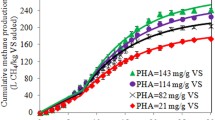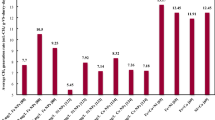Abstract
The process evaluation of zinc oxide nanoparticle (ZnO NP) was added to enhance the degradation of petroleum wastewater (PWW) fermentation system with different mixing ratios for enhancing methane production. The results showed that the highest methane yield and total solids (TS) removal ratio reached 485 mL/g-VS L PWW added and 81.9% at the ZnO NP g-VS L PWW ratio of 4.5:15, respectively. The proposed model CO2 sequester 545 mL CO2/L PWW, production rate 750 mL CH4 g-VS L PWW/h, and CH4 yield was 4.85 L CH4 g-VS L PWW at 4.5:15 of ZnO NP g-VS L PWW. The kinetic analysis indicated that the modified Gompertz model best fitted the actual evolution of methane yields, as evidenced by the low root mean square prediction error (RMSPE) as well as high correlation difference between (Diff.%) the predicted and actual values. The parameters analyses were highlighted that the PWW digestion with ZnO NP substantially enhanced the hydrolysis rate (khyd), methanogenesis potential (fd), lag phase time h (λ), and methane production rate (Rm) of PWW. The evolution of soluble metabolites, utilization of ZnO NP and carbohydrates were also improved by co-fermentation.






Similar content being viewed by others
Abbreviations
- PWW:
-
Petroleum wastewater
- VS:
-
Volatile solids
- COD:
-
Chemical oxygen demand (g/L)
- Alk:
-
Alkalinity
- BOD:
-
Biochemical oxygen demand (mg/L)
- D:
-
Dilution rate, 1/HRT (day_1)
- L:
-
Liter
- NH3-N:
-
Ammonia nitrogen (mg/L)
- O&G:
-
Oil and grease (mg/L)
- OLR:
-
Organic loading rate (kg/m3/day)
- S:
-
Substrate concentration in the reactor (mg/L)
- S1:
-
Influent substrate concentration (mg/L)
- S2:
-
Effluent substrate concentration (mg/L)
- SCOD:
-
Soluble chemical oxygen demand (mg/L)
- SRT:
-
Solid retention time (day)
- SS:
-
Suspended solid (mg/L)
- t :
-
Time (day)
- MLSS:
-
Mixed liquor suspended sludge (mg/L)
- SVI:
-
Sludge volume index (mL/L)
- TN:
-
Total nitrogen (mg/L)
- TS:
-
Total solid (mg/L)
- TVS:
-
Total volatile solid (mg/L)
- UASFF:
-
Upflow anaerobic sludge fixed film
- V:
-
Volume reactor (L)
- VFA:
-
Volatile fatty acid (mg/L)
- TC:
-
Total carbon
- VSS:
-
Volatile suspended solid (mg/L)
- SSV:
-
Sludge settling velocity (m/h)
- SMA:
-
Specific methanogenic activity
- Y :
-
measured methane yield (L/g CODadded)
- f d :
-
methane potential (mL g COD L POMEadded)
- Diff.%:
-
Difference between
- R m :
-
Methane production rate (mL/g COD/h)
- k hyd :
-
Hydrolysis rate (g COD/day)
- n :
-
Shape factor
- λ :
-
Lag phase time (h)
- S.E.E:
-
Standard error of estimate
- RMSE:
-
Root mean square prediction error
References
Wake, H. (2005). Oil refineries: a review of their ecological impacts on the aquatic environment. Estuarine, Coastal and Shelf Science, 62(1-2), 131–140.
Salehi, E., Madaeni, S. S., Shamsabadi, A. A., & Laki, S. (2014). Applicability of ceramic membrane filters in pretreatment of coke-contaminated petrochemical wastewater: economic feasibility study. Ceramics International, 40(3), 4805–4810.
Kesavan, P. L., & Victor, J. (2005). Partial identifiably of parameters in Monod kinetics and statistical analysis of residuals. Biochemical Engineering Journal, 24(2), 95–104.
Benali, M., Gerbaud, V., & Hemati, M. (2009). Effect of operating conditions and physico–chemical properties on the wet granulation kinetics in high shear mixer. Powder Technology, 190(1-2), 160.
Ahmad, A., & O-Aljasser, A. (2013). Anaerobic nitrogen, sulfide, and carbon removal in anaerobic granular bed reactor. Environmental Progress. https://doi.org/10.1002/ep.11882.
Guo-Ping, S., Han-Qing, Y., & Xiao-Yan, L. (2008). Stability of sludge flocs under shear conditions. Biochemical Engineering Journal, 38, 302.
Chitu, T. M., Oulahna, D., & Hemati, M. (2011). Wet granulation in laboratory-scale high shear mixers: effect of chopper presence, design and impeller speed. Powder Technology, 206(1–2), 34–43.
Ahmad, A. (2014). A novel application of red mud-iron on granulation and treatment of palm oil mill effluent using upflow anaerobic sludge blanket reactor. Environmental Technology, 35(21), 2718–2726. https://doi.org/10.1080/09593330.2014.919034.
De Lucas, A., Rodriguez, L., Villaserior, J., & Fernandez, F. J. (2005). Biodegradation kinetics of stored wastewater substrates by mixed microbial culture. Biochemical Engineering Journal, 26(2-3), 191–197.
Ahmad, A., & Wahid, Z. A. (2014). Immobilized cement kiln dust enhances biomass and neutralizing of palm oil mill effluent for biogas production. Environmental Progress, 34(3), 736–743. https://doi.org/10.1002/ep.12057.
Lombi, E., Donner, E., Tavakkoli, E., Turney, T. W., Naidu, R., Miller, B. W., & Scheckel, K. G. (2012). Fate of zinc oxide nanoparticles during anaerobic digestion of wastewater and post-treatment processing of sewage sludge. Environmental Science & Technology, 46(16), 9089–9096.
Ahmad, A., & Ghufran, R. (2014). Evaluation of the bio-kinetics of cement kiln dust in an upflow anaerobic sludge blanket reactor for treatment of palm oil mill effluent as a function of hydraulic retention time. Separation and Purification Technology, 133, 129–137.
Ahmad, A., Ghufran, R., & Wahid, Z. A. (2011a). Role of calcium oxide in sludge granulation and methanogenesis for the treatment of palm oil mill effluent using UASB reactor. Journal of Hazardous Materials, 198, 40–48.
Vlyssides, A., Barampouti, E. M., & Mai, S. (2008). Determination of granule size distribution in a UASB reactor. Journal of Environmental Management, 86(4), 660–664.
Shariati, S. R. P., Bonakdarpour, B., Zare, N., & Ashtiani, F. Z. (2011). The effect of hydraulic retention time on the performance and fouling characteristics of membrane sequencing batch reactors used for the treatment of synthetic petroleum refinery wastewater. Bioresource Technology, 102(17), 7692–7699.
Wang, G., Dai, X., Zhang, D., He, Q., Dong, B., Li, N., & Ye, N. (2018). Two-phase high solid anaerobic digestion with dewatered sludge: improved volatile solid degradation and specific methane generation by temperature and pH regulation. Bioresource Technology, 259, 253–258.
Mu, H., Chen, Y., & Xiao, N. (2011). Effects of metal oxide nanoparticles (TiO2, Al2O3, SiO2 and ZnO) on waste activated sludge anaerobic digestion. Bioresource Technology, 102(22), 10305–10311.
Ahmad, A. (2018). Process evaluation for petroleum wastewater co-digestion with rye grass to enhance methane production. Waste and Biomass Valorization, 1–11. https://doi.org/10.1007/s12649-018-0473-9.
Zamanzadeh, M., Parker, W. J., Verastegui, Y., & Neufeld, J. D. (2013). Biokinetics and bacterial communities of propionate oxidizing bacteria in phased anaerobic sludge digestion systems. Water Research, 47(4), 1558–1569.
Latif, M. A., Ahmad, A., Ghufran, R., & Wahid, Z. A. (2011a). Integrated application of upflow anaerobic sludge blanket reactor for the treatment of wastewaters. Water Research, 45(16), 4683–4699.
Kim, J., Lee, S., & Lee, C. (2013). Comparative study of changes in reaction profile and microbial community structure in two anaerobic repeated-batch reactors started up with different seed sludges. Bioresource Technology, 129, 495–505.
Al-Malack, M. H. (2006). Determination of biokinetic coefficients of an immersed membrane bioreactor. Journal of Membrane Science, 271, 46.
Latif, M. A., Ahmad, A., Ghufran, R., & Wahid, Z. A. (2011b). Effect of temperature and organic loading rate on upflow anaerobic sludge blanket reactor (USBR) by treating liquidized food waste. Environmental Progress, 3, 114.
Zhen, G. Y., Lu, X. Q., Kobayashi, T., Li, Y. Y., Xu, K. Q., & Zhao, Y. C. (2015). Mesophilic anaerobic co-digestion of waste activated sludge and Egeria densa: performance assessment and kinetic analysis. Applied Energy, 148, 78–86.
Ahmad, A., & Ghufran, R. (2018). Review on industrial wastewater energy sources and carbon emission reduction: towards a clean production. International Journal of Sustainable Engineering. https://doi.org/10.1080/19397038.2018.1423647.
Dai, X., Li, X., Zhang, D., Chen, Y., & Dai, L. (2016). Simultaneous enhancement of methane production and methane content in biogas from waste activated sludge and perennial ryegrass anaerobic co-digestion: the effects of pH and C/N ratio. Bioresource Technology, 216, 323–330.
Zheng, Y. M., & Yu, H. Q. (2007). Determination of the pore size distribution and porosity of aerobic granules using size-exclusion chromatography. Water Research, 41(1), 39–46.
Kim, H. W., Nam, J. Y., & Shin, H. S. (2011). A comparison study on the high-rate co-digestion o sewage sludge and food waste using a temperature-phased anaerobic sequencing batch reactor system. Bioresource Technology, 102(2011), 7272–7279.
Pastor, L., Ruiz, L., Pascual, A., & Ruiz, B. (2013). Co-digestion of used oils and urban landfill leachates with sewage sludge and the effect on the biogas production. Applied Energy, 107(2013), 438–445.
Nyberg, L., Turco, R. F., & Nies, L. (2008). Assessing the impact of nanomaterials on anaerobic microbial communities. Environmental Science & Technology, 42(6), 1938–1943.
Dai, X., Li, X., Zhang, D., Chen, Y., & Dai, L. (2016). Simultaneous enhancement of methane production and methane content in biogas from waste activated sludge and perennial ryegrass anaerobic co-digestion: the effects of pH and C/N ratio. Bioresource Technology, 216(2016), 323–330.
Nizami, A. S., & Jerry, D. (2011). Murphy, Optimizing the operation of a two-phase anaerobic digestion system digesting grass silage. Environmental Science & Technology, 45(17), 7561–7569.
Gao, D., Liu, L., Liang, H., & Wu, W. M. (2011). Aerobic granular sludge: characterization, mechanism of granulation and application to wastewater treatment. Critical Reviews in Biotechnology, 31(2), 137.
Chen, J. J. (2010). Biomass to renewable energy processes. Boca Raton London: CRC Press, Taylor & Francis Group.
El-Mashad, H. M. (2013). Kinetics of methane production from the co-digestion of switch grass and Spirulina platensis algae. Bioresource Technology, 132, 305–312.
Ahmad A (2012) Calcium oxide cement kiln dust for granulation of palm oil mill effluent Patent and Trademark Office, United States Department of Commerce, Washington, DC, USA, Patent No. 20120285884A1.
Mu, H., Zheng, X., Chen, Y., Chen, C., & Liu, K. (2012). Response of anaerobic granular sludge to a shock load of zinc oxide nanoparticles during biological wastewater treatment. Environmental Science & Technology, 46(11), 5997–6003.
Ahmad, A., Ghufran, R., & Wahid, Z. A. (2011a). Bioenergy from anaerobic degradation of lipids in palm oil mill effluent. Biomass and Bioenergy. Reviews in Environmental Science and Biotechnology, 10, 353.
Otero-González, L., Jim, A. F., & Sierra-Alvarez, R. (2014). Fate and long-term inhibitory impact of ZnO nanoparticles during high-rate anaerobic wastewater treatment. Journal of Environmental Management, 135, 110–117.
Acknowledgments
The authors thank the deanship of scientific research (DSR) at the University of Nizwa (UNIZWA) for this research by the Research Cluster Group Energy, Environment and Sustainable technology.
Author information
Authors and Affiliations
Corresponding author
Ethics declarations
Competing Interests
The authors declare that they have no conflicts of interest.
Additional information
Publisher’s Note
Springer Nature remains neutral with regard to jurisdictional claims in published maps and institutional affiliations.
Rights and permissions
About this article
Cite this article
Ahmad, A. Bioprocess Evaluation of Petroleum Wastewater Treatment with Zinc Oxide Nanoparticle for the Production of Methane Gas: Process Assessment and Modelling. Appl Biochem Biotechnol 190, 851–866 (2020). https://doi.org/10.1007/s12010-019-03137-4
Received:
Accepted:
Published:
Issue Date:
DOI: https://doi.org/10.1007/s12010-019-03137-4




